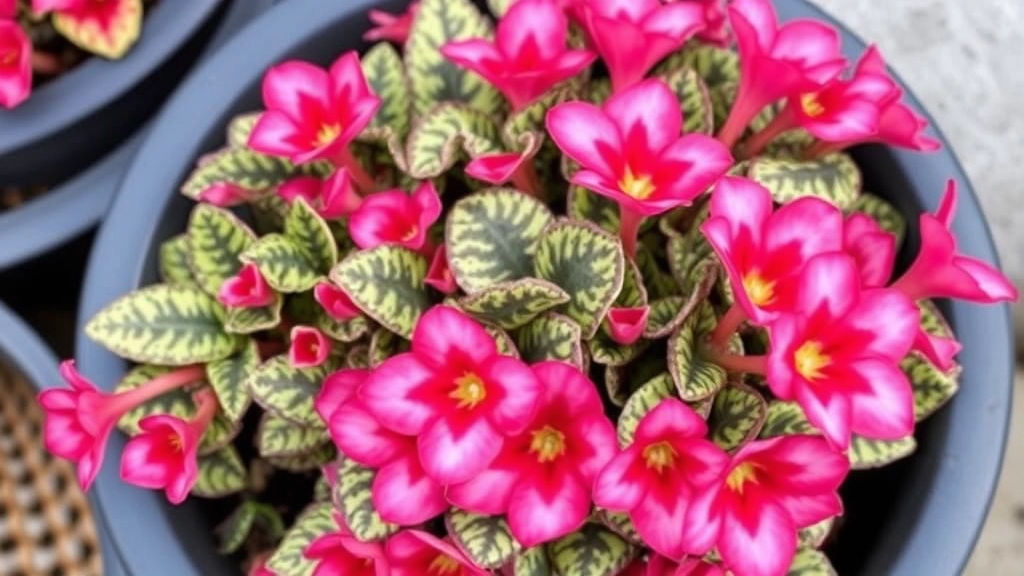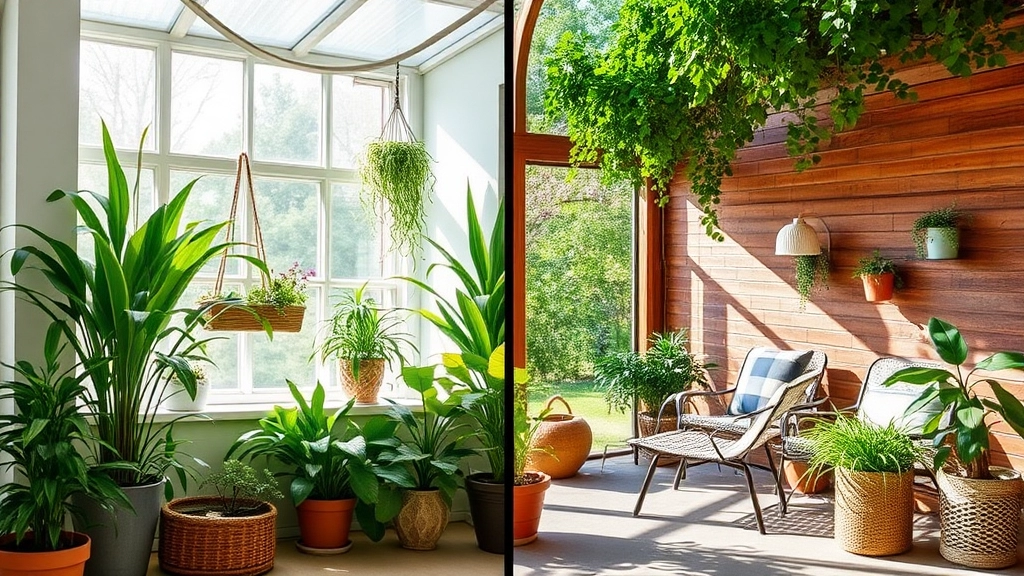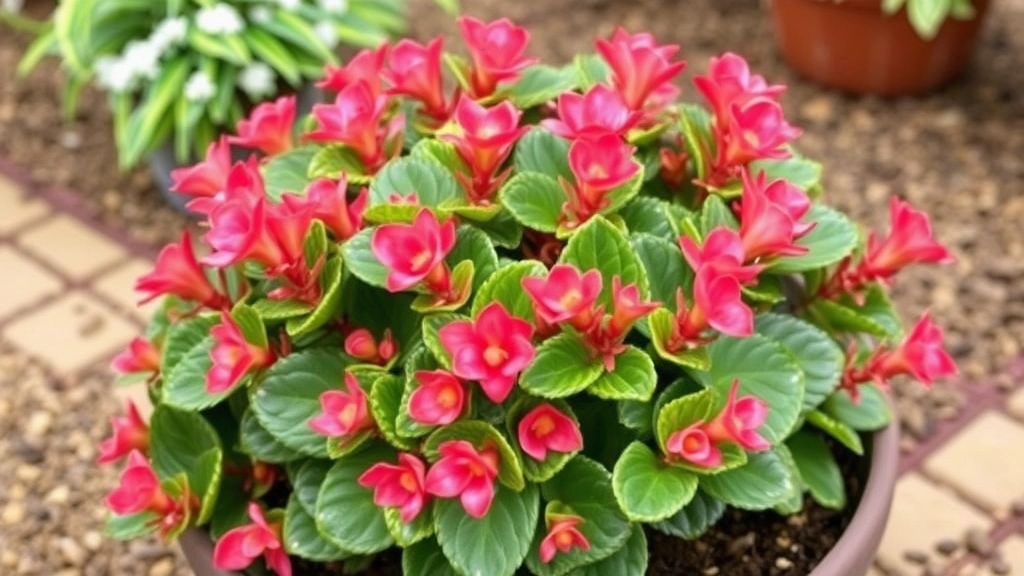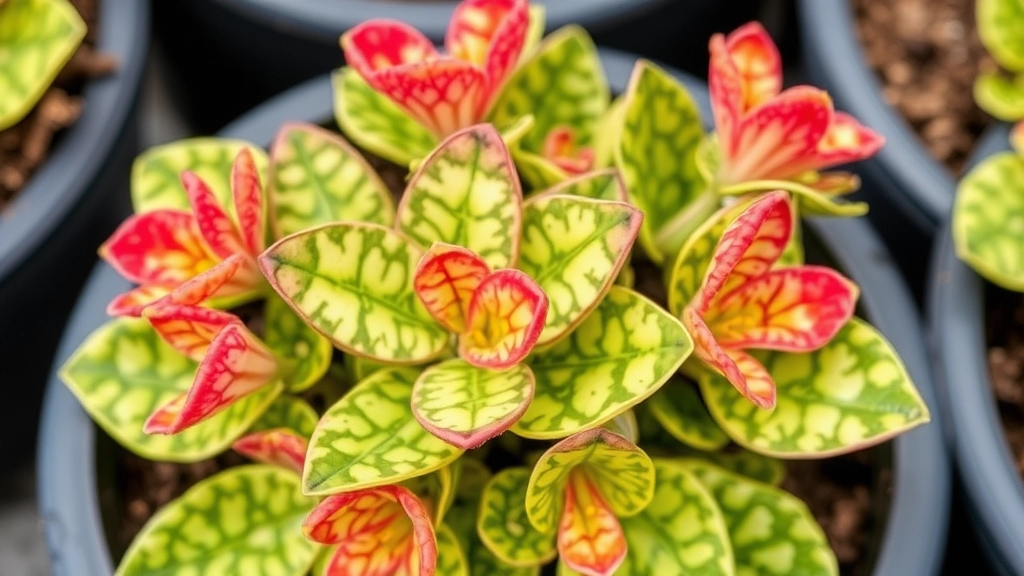Kalanchoe Beharensis Variegated: A Unique Houseplant
When it comes to unique and eye-catching houseplants, the Kalanchoe Beharensis Variegated stands out with its striking foliage and easy care requirements. This variegated variety of Kalanchoe Beharensis, often referred to as the “Felt Bush,” is perfect for both indoor and outdoor spaces, offering a blend of aesthetic appeal and low maintenance. In this guide, I’ll share essential tips on growing, maintaining, and propagating this beautiful plant to help you make the most of its unique features.
Optimal Growing Conditions
Understanding the optimal growing conditions for Kalanchoe Beharensis Variegated is crucial for its health and longevity. This plant thrives in well-draining soil and requires moderate watering, making it an excellent choice for those who might not have a green thumb. Whether you’re placing it indoors or outdoors, ensuring it gets ample light will keep its foliage vibrant and lush.
Care Tips
Read on to discover more about soil and watering needs, light requirements, and seasonal care tips to keep your Kalanchoe Beharensis Variegated flourishing year-round.
When considering the Kalanchoe Beharensis Variegated, you might wonder what makes it stand out among other succulent plants.
This unique variety, often referred to as the ‘Chandelier Plant’, showcases stunning, fleshy leaves that are adorned with striking cream and green variegation.
Key Features:
– **Leaf Shape:** The leaves are large, paddle-shaped, and can grow up to 10 inches long.
– **Growth Habit:** It typically grows upright, reaching heights of 3 to 4 feet.
– **Flowering:** While not its main attraction, it can produce small, tubular flowers in clusters, often in a vibrant orange hue.
– **Texture:** The leaves have a slightly waxy texture, which helps retain moisture.
Kalanchoe Beharensis Variegated is not just a visual delight; it’s also relatively low-maintenance, making it an excellent choice for both novice and experienced gardeners alike. For more detailed care instructions, you can refer to the [complete care guide for Kalanchoe Beharensis Felt Plant](https://planthq.org/complete-care-guide-for-kalanchoe-beharensis-felt-plant/). Additionally, if you’re interested in other varieties, check out the [care and propagation of Kalanchoe Beharensis Tree](https://planthq.org/care-and-propagation-of-kalanchoe-beharensis-tree/).
Optimal Growing Conditions for Kalanchoe Beharensis Variegated

So, you’ve got your Kalanchoe Beharensis Variegated, and you’re eager to help it thrive. But what are the best conditions to ensure your plant is happy and healthy?
Temperature
Kalanchoe Beharensis Variegated loves warmth. Ideally, keep it in temperatures between 20°C to 30°C (68°F to 86°F).
Humidity
These plants prefer low to moderate humidity. A dry environment mimics their natural habitat, so don’t worry about misting.
Air Circulation
Good airflow is crucial. Avoid cramped spots where air doesn’t flow. A little breeze helps prevent fungal issues.
Fertilizer
Feed your plant during the growing season (spring and summer) with a balanced, diluted fertilizer. Just once a month is enough to keep it nourished.
Pot Size
Choose a pot that’s not too big. A snug fit encourages growth without the risk of root rot.
Soil and Watering Requirements
Understanding the soil and watering needs of Kalanchoe Beharensis Variegated is crucial for its thriving health. Many plant enthusiasts worry about overwatering or using the wrong soil type, which can lead to problems like root rot.
Soil Requirements
Kalanchoe Beharensis Variegated thrives in well-draining soil. Here’s what to consider:
- Soil Type: A cactus or succulent mix works wonders. Alternatively, you can create your own blend by mixing regular potting soil with sand or perlite.
- pH Level: Aim for a slightly acidic to neutral pH, ideally between 6.0 and 7.0.
- Drainage: Ensure your pot has drainage holes to prevent water accumulation.
Using the right soil not only supports healthy growth but also helps prevent common issues like root rot.
Watering Guidelines
Watering can be a tricky balance for many plant owners. Here’s how to get it right:
- Frequency: Water your Kalanchoe Beharensis Variegated when the top inch of the soil feels dry. This usually means every 2-3 weeks, but it can vary based on your environment.
- Method: Water thoroughly until it drains out of the bottom. Avoid letting the plant sit in standing water.
- Seasonal Adjustments: In winter, reduce watering as the plant enters dormancy.
By following these soil and watering guidelines, you’ll create a nurturing environment for your Kalanchoe Beharensis Variegated. For more detailed care tips, you can refer to our expert tips for healthy growth. Additionally, if you’re interested in propagating this beautiful plant, check out our successful propagation guide.
Light Needs: Indoor vs Outdoor Placement

When considering the best light conditions for your Kalanchoe Beharensis Variegated, you might wonder if it thrives better indoors or outdoors. Understanding its light requirements is crucial for ensuring vibrant growth and health.
Indoor Placement
For indoor settings, Kalanchoe Beharensis Variegated prefers bright, indirect light. Here are some tips to optimise its indoor placement:
- South or West-facing windows: These locations provide the most sunlight.
- Avoid direct sunlight: Too much direct sunlight can scorch the leaves, leading to unsightly brown patches.
- Rotate your plant: This ensures even light exposure and promotes balanced growth.
Outdoor Placement
If you’re considering outdoor placement, your Kalanchoe will flourish in a warm, sunny environment. Here’s what to keep in mind:
- Partial shade: While it enjoys sunlight, a few hours of partial shade during the hottest part of the day can prevent leaf burn.
- Avoid frost: Ensure that the plant is brought indoors if temperatures drop below 5°C, as it is not frost-tolerant.
- Monitor light exposure: Adjust its position based on the season; in summer, it may need more shade compared to spring or autumn.
Propagation Techniques: Leaf and Stem Cuttings
When it comes to expanding your collection of Kalanchoe Beharensis Variegated, propagation can feel daunting.
But worry not; it’s simpler than you might think!
Leaf Cuttings
- Select Healthy Leaves: Choose mature, healthy leaves from the parent plant.
- Prepare the Cut: Use a clean, sharp knife or scissors to cut the leaf.
- Drying Time: Allow the cut leaf to dry for 1-2 days. This helps prevent rot.
- Planting: Place the leaf on top of well-draining soil, ensuring it’s not buried.
- Watering: Mist lightly to keep the soil slightly moist but not soggy.
Stem Cuttings
- Choose a Stem: Look for a healthy stem with at least a few leaves.
- Make the Cut: Cut a section of the stem about 4-6 inches long.
- Let it Callous: Just like with leaf cuttings, allow the cut end to dry for a day or two.
- Planting: Insert the calloused end into well-draining soil.
- Watering: Water sparingly until roots develop.
Both methods can yield successful results, but patience is key. For more detailed steps, you can refer to this guide on propagating Kalanchoe Beharensis Fang.
In a few weeks, you should notice new growth, signalling that your cuttings have taken root.
Common Pitfalls to Avoid
- Overwatering is the most common mistake. For best practices, check out the watering tips for Kalanchoe Tomentosa.
- Ensure your cuttings receive adequate light but avoid direct sunlight initially.
As you nurture your new plants, keep an eye on their growth and adjust care as needed.
Seasonal Care Tips for Kalanchoe Beharensis

So, you’ve got your stunning Kalanchoe Beharensis Variegated, and now you’re wondering how to keep it thriving throughout the seasons? You’re not alone! Many plant parents face challenges as the weather changes.
Spring Awakening
- As the days get longer and warmer, your Kalanchoe will start to wake up from its winter slumber.
- Repotting: This is a great time to consider repotting if you notice roots peeking out of the drainage holes.
- Fertiliser: Start feeding it with a balanced fertiliser every few weeks to kickstart its growth.
Summer Sunshine
- Your plant will love the bright summer light, but keep an eye on it.
- Watering: Increase your watering frequency, but make sure the soil dries out between sessions.
- Humidity: If it’s particularly humid, ensure good airflow to prevent rot.
Autumn Adjustments
- As temperatures drop, your Kalanchoe will slow down.
- Reduce Watering: Scale back on watering as the plant enters dormancy.
- Light: Ensure it still gets enough light, but avoid direct harsh sunlight during the late afternoon.
Winter Care
- This is the trickiest time for your Kalanchoe.
- Temperature: Keep it in a warm spot, ideally above 10°C, as it can be sensitive to cold drafts.
- Minimal Watering: Water sparingly; your plant is in survival mode!
As we delve deeper into the care of Kalanchoe Beharensis Variegated, it’s crucial to address potential threats to its health.
### Common Pests
Kalanchoe Beharensis Variegated can attract a few unwelcome guests. Here are the most common pests you might encounter:
– **Aphids**: Small, soft-bodied insects that suck the sap from your plant, leading to stunted growth.
– **Mealybugs**: These pests appear as white, cottony masses on the leaves and stems, causing leaf drop and weakening the plant.
– **Spider Mites**: Tiny and often unnoticed, these pests can create webbing, particularly in dry conditions.
– **Scale Insects**: They resemble small bumps on the stems and leaves, sucking sap and leading to yellowing foliage.
### Common Diseases
In addition to pests, Kalanchoe Beharensis can be susceptible to a few diseases:
– **Root Rot**: Often caused by overwatering, this disease can lead to wilting and eventual death of the plant.
– **Powdery Mildew**: A fungal disease that presents as a white powdery coating on leaves, usually due to high humidity and poor air circulation.
### Prevention Tips
To keep your Kalanchoe Beharensis healthy, here are some effective prevention strategies:
– **Regular Inspection**: Check your plant weekly for signs of pests or disease.
– **Proper Watering**: Ensure you allow the soil to dry out between waterings to prevent root rot.
– **Good Airflow**: Position your plant to ensure adequate air circulation, reducing humidity levels that can lead to diseases.
– **Neem Oil**: This natural pesticide can deter pests without harming the plant.
– **Clean Leaves**: Wipe leaves with a damp cloth to remove dust and potential pests.
For more detailed care tips, you might find this [complete care guide for Kalanchoe Beharensis](https://planthq.org/complete-care-guide-for-kalanchoe-beharensis-felt-plant/) helpful. Additionally, understanding the [medicinal uses and health benefits of Kalanchoe Pinnata](https://planthq.org/medicinal-kalanchoe-pinnata-health-benefits-and-uses/) can provide insights into the broader applications of this plant family.
VIII. Landscaping and Decorative Uses of Kalanchoe Beharensis Variegated

So, you’ve got your Kalanchoe Beharensis Variegated thriving, and now you’re wondering how to showcase its beauty, right?
This stunning succulent isn’t just a pretty face; it’s versatile and can elevate any space. Here are some creative ways to incorporate it into your landscaping and home decor:
Outdoor Landscaping
- Rock Gardens: The Kalanchoe Beharensis adds a unique texture to rock gardens. Its variegated leaves contrast beautifully with gravel and stones.
- Succulent Borders: Use it as a border plant in your garden beds. The bold foliage can frame pathways or flower beds perfectly.
- Containers and Pots: Pair it with other succulents in a decorative pot. It thrives in containers, making it ideal for patios or balconies.
Indoor Decoration
- Statement Piece: Place a larger Kalanchoe Beharensis in a stylish pot as a focal point in your living room or office. Its striking appearance draws the eye.
- Window Sills: They love light! Position them on window sills where they can soak up the sun while adding greenery to your space.
- Table Centrepieces: Use smaller plants in unique pots as centrepieces for dining or coffee tables. They add a touch of nature without overwhelming the space.
Seasonal Displays
- Seasonal Decor: Change the pot or surrounding decor for the seasons. For instance, use earthy tones in autumn or vibrant colours in summer.
- Festive Touches: Add fairy lights around the plant during the holidays for a whimsical touch.
Kalanchoe Beharensis Variegated is not just a plant; it’s a versatile design element that can enhance both indoor and outdoor spaces.
Finding the perfect Kalanchoe Beharensis Variegated can be a bit of a quest. You might be wondering where to source this stunning plant and what to consider for shipping.
### Where to Buy
– **Local Nurseries:**
– Visiting a local nursery allows you to inspect the plant before purchasing.
– Staff can often provide care tips tailored to your area.
– **Online Retailers:**
– Websites like Amazon, Etsy, and specialized plant shops often have a selection. Check reviews to ensure you’re buying from a reputable seller.
– For more specific advice, you might want to look into the [complete care guide for Kalanchoe Beharensis Felt Plant](https://planthq.org/complete-care-guide-for-kalanchoe-beharensis-felt-plant/).
– **Plant Expos and Markets:**
– Local plant fairs can be treasure troves for unique varieties.
– Engaging with vendors can offer insights into care and propagation.
### Shipping Considerations
When ordering online, shipping can be a critical factor. Here’s what to keep in mind:
– **Temperature Sensitivity:**
– Kalanchoe Beharensis Variegated is sensitive to extreme temperatures. Choose a seller that ships during mild weather.
– You can also refer to the [ideal temperature for Kalanchoe Blossfeldiana growth](https://planthq.org/ideal-temperature-for-kalanchoe-blossfeldiana-growth/) for additional temperature guidelines.
– **Packaging:**
– Ensure the plant is well-packaged to avoid damage during transit.
– Look for sellers that use biodegradable packing materials.
– **Delivery Time:**
– Opt for expedited shipping if possible. This reduces the time the plant spends in transit, minimizing stress.
– **Return Policy:**
– Always check the return policy in case the plant arrives damaged. A good seller will offer a satisfaction guarantee.
FAQs on Kalanchoe Beharensis Variegated
What are the ideal temperature conditions for Kalanchoe Beharensis Variegated?
Kalanchoe Beharensis Variegated thrives in warm temperatures, ideally between 20°C to 30°C (68°F to 86°F).
Does Kalanchoe Beharensis Variegated require high humidity?
No, these plants prefer low to moderate humidity. A dry environment is more suitable, mimicking their natural habitat.
How important is air circulation for Kalanchoe Beharensis Variegated?
Good airflow is crucial. Avoid placing the plant in cramped areas where air doesn’t circulate well. A little breeze helps prevent fungal issues.
How often should I fertilize my Kalanchoe Beharensis Variegated?
Feed your plant with a balanced, diluted fertilizer once a month during the growing season (spring and summer).
What size pot should I use for Kalanchoe Beharensis Variegated?
Choose a pot that’s not too big. A snug fit encourages growth without the risk of root rot.
What kind of light does Kalanchoe Beharensis Variegated need indoors?
Indoors, it prefers bright, indirect light. South or west-facing windows are ideal, but avoid direct sunlight to prevent leaf scorch.
Can I place my Kalanchoe Beharensis Variegated outdoors?
Yes, it can be placed outdoors in a warm, sunny environment. Ensure it gets partial shade during the hottest part of the day and avoid frost.
How should I care for my Kalanchoe Beharensis Variegated in different seasons?
Seasonal care varies:
- Spring: Consider repotting and start fertilizing.
- Summer: Increase watering but ensure soil dries out between sessions.
- Autumn: Reduce watering and ensure it still gets enough light.
- Winter: Keep it in a warm spot above 10°C and water sparingly.
How can I use Kalanchoe Beharensis Variegated in landscaping?
It is versatile for outdoor landscaping:
- Rock Gardens: Adds unique texture.
- Succulent Borders: Frames pathways or flower beds.
- Containers and Pots: Ideal for patios or balconies.
How can I incorporate Kalanchoe Beharensis Variegated into indoor decor?
For indoor decoration:
- Statement Piece: Use as a focal point in a stylish pot.
- Window Sills: Position where it can soak up the sun.
- Table Centrepieces: Use smaller plants for dining or coffee tables.
Can I use Kalanchoe Beharensis Variegated for seasonal displays?
Absolutely! You can:
- Seasonal Decor: Change the pot or surrounding decor for different seasons.
- Festive Touches: Add fairy lights during holidays for a whimsical touch.
References
-
How to Grow Kalanchoe Beharensis Indoors
-
Tips for Growing Kalanchoe Beharensis
-
Kalanchoe Beharensis Care Guide
